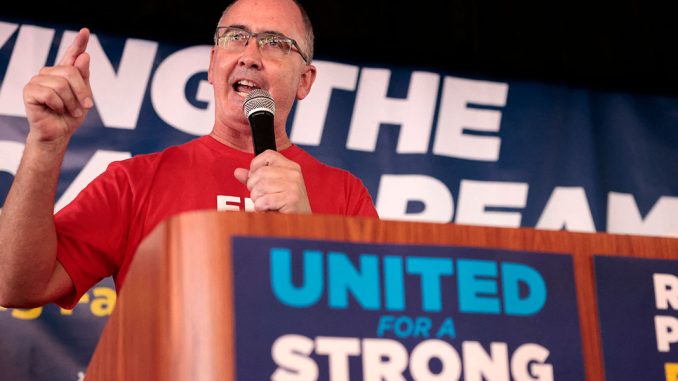
Divorced from economic reality, the new leader of the United Auto Workers union has made exorbitant demands that, by roughly doubling the compensation of many workers, threaten the future of the Big 3 U.S. automakers and their hundreds of thousands of employees.
The UAW’s current contracts with the Big 3—General Motors, Ford, and Stellantis (formerly Chrysler)—expire at 11:59 p.m. Thursday. Absent a deal, the union stands ready to strike.
Shawn Fain is the first UAW president to be elected by members themselves, following a massive corruption scandal. Federal prosecutors characterized the union’s leadership—some of whom received jail time—as “riddled with corruption” and “fatally compromised in its ability to represent the best interests of the UAW’s members and their families.”
In the current talks, Fain demanded a 46% increase in base pay for hourly workers. With base wages currently ranging from a reported $17 per hour for temporary workers to $32.32 for top-scale assembly workers, the 46% jump would put the range between $24.82 and $47.18 per hour, or $51,600 to $98,100 a year in annual pay.
But that’s just the start. The union is demanding a 32-hour work week, for which workers would receive 40 hours of pay. That’s like paying for five days’ worth of groceries, but receiving only four days of food.
The UAW’s “pay more for less” demands would bring the true hourly range for workers to between $31.02 and $58.98 per hour. The median hourly wage for all manufacturing workers across the U.S. is $26.59 per hour.
At nearly $59 per hour, UAW workers could earn 50% more per hour than registered nurses and 59% more per year than elementary teachers.
And hiring 25% more workers to produce the same output would create the added cost of providing health insurance and retirement benefits to those new workers. Moreover, the UAW is demanding that the Big 3 automakers reinstate costly medical retirement benefits and defined benefit pensions for newer hires, as well as increase pension checks for current retirees.
Excessive and underfunded union pension benefits were a major cause of the Big 3’s near collapse in 2008. And without taxpayers being forced to subsidize an estimated $30 billion in broken pension promises and other compensation for union workers, current retirees would receive only a fraction of promised benefits.
The reality is that these demands are unsustainable in the globally competitive economy of 2023.
There was a time—roughly three-quarters of a century ago—when the only cars Americans could buy were those produced in the United States by members of the United Auto Workers. Thus, the union could impose above-market compensation without the threat of competition.
Although that might have been good for a small group of auto workers, it also meant higher prices for cars, fewer Americans able to afford them, and fewer workers needed to produce them.
The entry of foreign-made automobiles brought down the cost of cars and made them more widely available to average Americans. But the UAW’s failure to adjust its excessive compensation demands and restrictive workplace rules made U.S. cars less competitive and undoubtedly contributed to the shuttering of unionized auto manufacturing plants over the past decades.
Domestic auto production is less than half of what it was two decades ago, even as Americans are buying about the same number of cars per year.
The UAW’s demands include complaints that the Big 3 automakers have closed 65 plants over the past two decades, which clearly hurts workers and communities. But unions can’t inoculate companies from economic reality.
A basic supply-and-demand graph will demonstrate that if you increase the price of something by jacking up the labor costs of producing it, you’ll get less demand for it. And that simply will mean more shuttered U.S. plants and fewer jobs for UAW members.
Labor costs at the Big 3 already are estimated to be about one-third higher than elsewhere, ranging from $66 to $72 per hour in 2023 compared to an average of $52 per hour for nonunionized foreign automakers in the U.S.
The UAW’s demands could double current labor costs. And unless consumers are willing to pay thousands of dollars more for cars made by unionized workers, those higher costs could bring down the Big 3 and the union.
Already, only about 14% of U.S. auto workers are unionized. Foreign-owned automakers now employ more U.S. workers than domestic automakers do.
At the end of the day, workers can’t be paid more than the value of what they produce. What they produce is determined in large part by the education and training they receive, as well as the attendant capital and technology.
So instead of trying to strong-arm the Big 3 automakers into paying workers more money to do less, the United Auto Workers should look for ways to help workers and automakers grow together. The union should focus on the education and innovation necessary to help automakers compete, so that they can open new factories instead of shuttering existing ones.
And UAW members should hope that the union’s current demands are not met. If they are, the result almost certainly will be fewer cars produced and fewer workers employed by the Big 3.
Have an opinion about this article? To sound off, please email letters@DailySignal.com, and we’ll consider publishing your edited remarks in our regular “We Hear You” feature. Remember to include the URL or headline of the article plus your name and town and/or state.

Be the first to comment